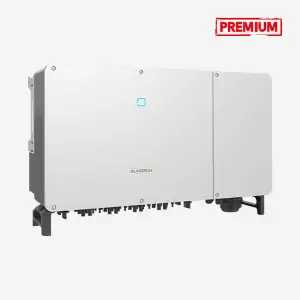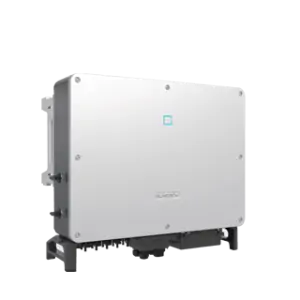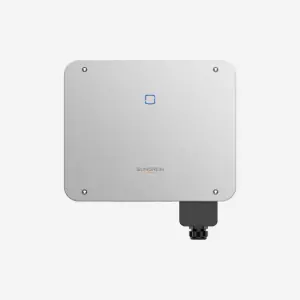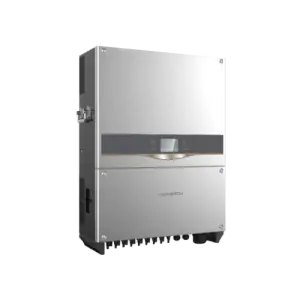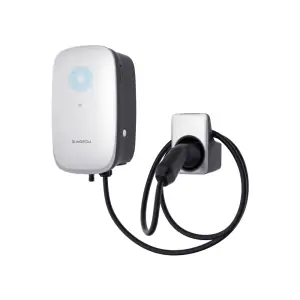Sungrow Solar Inverters in UAE
Welcome to Sungrow Solar Inverters, where cutting-edge technology meets sustainable energy solutions. Sungrow is a globally recognized leader in solar inverter technology, dedicated to maximizing the efficiency and reliability of your solar power system.
Why Choose Sungrow Solar Inverters:
- Efficiency Beyond Compare: Sungrow’s solar inverters are engineered for exceptional efficiency, ensuring that every ray of sunlight is harnessed to its fullest potential, converting it into clean, usable electricity for your home or business.
- Unwavering Reliability: Trust in the longevity and resilience of Sungrow Solar Inverters. Built to endure diverse environmental conditions, they deliver consistent and dependable performance year after year.
- Seamless Grid Integration: Our solar inverters seamlessly synchronize with your local power grid, facilitating the efficient transfer of surplus energy. You can even earn credits or reduce your electricity bills by selling excess energy back to the grid.
- Smart Monitoring: Stay informed with real-time monitoring of your solar power system. Sungrow’s user-friendly monitoring tools empower you to track energy production, system health, and savings, all from the convenience of your smartphone or computer.
- Installer-Friendly Design: Designed with simplicity in mind, Sungrow Solar Inverters are installer-friendly, ensuring a hassle-free installation process for solar professionals.
Sungrow On-grid Inverter: Harnessing Solar Power for Grid Connection
Sungrow On-grid Inverters are a crucial component of a solar photovoltaic (PV) system designed to convert the direct current (DC) electricity generated by solar panels into alternating current (AC) electricity that can be used in homes, businesses, or fed back into the electrical grid. Here’s a breakdown of the key features and benefits of Sungrow On-grid Inverters:
1. High Efficiency: Sungrow On-grid Inverters are engineered for high efficiency, ensuring that they can convert a significant portion of the sunlight captured by solar panels into usable electricity. This translates to maximum energy production from your solar PV system, leading to reduced energy bills and quicker returns on your investment.
2. Grid Compatibility: These inverters are specifically designed to work in harmony with the local power grid. They synchronize with the grid’s voltage and frequency, allowing seamless injection of surplus electricity back into the grid when your solar system produces more energy than you consume. This can result in financial benefits such as net metering or feed-in tariffs, depending on your location.
3. Reliable Performance: Sungrow is renowned for the reliability of its products. Sungrow On-grid Inverters are built to endure various environmental conditions, ensuring that they provide stable and consistent performance over the long term. This reliability minimizes maintenance requirements and maximizes the lifespan of your solar PV system.
4. Smart Monitoring: Sungrow offers smart monitoring solutions that enable real-time monitoring of your solar PV system’s performance. With these tools, you can track energy production, system health, and energy savings from the convenience of your smartphone or computer. This data empowers you to optimize your energy usage and make informed decisions about your solar system.
5. Easy Installation: Sungrow On-grid Inverters are designed with user-friendly installation in mind. Solar professionals can easily integrate them into your solar PV system, reducing installation time and costs.
6. Contributing to Sustainability: By using Sungrow On-grid Inverters, you play a part in the global shift towards clean, renewable energy. Solar power reduces greenhouse gas emissions and dependence on fossil fuels, contributing to a more sustainable and eco-friendly energy landscape.
Sungrow On-grid Inverters are suitable for both residential and commercial solar PV installations. Whether you are looking to reduce your electricity bills, increase your energy independence, or minimize your environmental footprint, Sungrow On-grid Inverters are a reliable and efficient choice for converting solar energy into usable power while seamlessly interacting with your local electrical grid.
Sungrow Hybrid Inverter: Combining Solar Power and Energy Storage
Sungrow Hybrid Inverters represent a versatile and intelligent solution for maximizing the potential of solar energy in your home or business. These inverters seamlessly integrate solar panels with energy storage systems, such as batteries, to provide you with a more reliable and flexible energy supply. Here’s an overview of the key features and benefits of Sungrow Hybrid Inverters:
1. Solar Integration: Sungrow Hybrid Inverters are designed to work with both solar panels and energy storage solutions. During daylight hours, they convert the DC electricity generated by solar panels into AC electricity for immediate use in your home or business. Any surplus energy generated can be stored in batteries for later use.
2. Battery Storage: One of the standout features of Sungrow Hybrid Inverters is their compatibility with energy storage systems, such as lithium-ion batteries. This allows you to store excess solar energy during the day and use it during the night or during power outages. It provides greater energy independence and can help you reduce your reliance on the grid.
3. Grid Connectivity: Sungrow Hybrid Inverters offer seamless grid connectivity. They can operate in grid-tied mode, which allows you to sell excess energy back to the grid or draw power from the grid when your solar system is not producing enough electricity. This flexibility ensures that you have a reliable power supply at all times.
4. Efficiency: Sungrow places a strong emphasis on efficiency in its hybrid inverter technology. These inverters are engineered to maximize the efficiency of energy conversion and storage, ensuring that you get the most out of your solar and battery system.
5. Remote Monitoring: Sungrow provides user-friendly monitoring solutions that enable real-time tracking of your solar energy production and storage. This information is easily accessible from your smartphone or computer, allowing you to stay informed about your system’s performance, energy savings, and battery status.
Sungrow Hybrid Inverters empower you to take control of your energy consumption and costs. Whether you want to achieve greater energy independence, reduce electricity bills, or ensure uninterrupted power supply during outages, Sungrow Hybrid Inverters offer a smart and efficient solution. By combining solar energy generation with energy storage, you can make the most of clean, renewable energy while enjoying the peace of mind that comes with a reliable backup power source.
Sungrow inverter datasheet
A Sungrow inverter datasheet is a technical document that provides detailed information about a specific model or type of Sungrow inverter. This document is essential for installers, technicians, and individuals involved in the design, installation, and maintenance of solar PV (photovoltaic) systems using Sungrow inverters. Here’s an explanation of the typical contents found in a Sungrow inverter datasheet:
- Model and Product Information: The datasheet usually begins with the model name and number of the inverter. This information helps identify the specific inverter variant being described.
- Technical Specifications: This section provides a comprehensive list of technical specifications, including:
- Input Specifications: Details about the DC (direct current) input, such as the maximum DC voltage and DC current the inverter can handle.
- Output Specifications: Information about the AC (alternating current) output, including maximum AC power output, AC voltage range, and AC current rating.
- Efficiency Data: Inverter efficiency under different operating conditions, including peak efficiency and partial load efficiency.
- Protection Features: Descriptions of built-in protection mechanisms, such as overvoltage protection, overcurrent protection, and temperature monitoring.
- Operating Conditions: This section outlines the recommended operating conditions for the inverter, including temperature range, altitude limitations, and humidity levels.
- Installation Requirements: Details on how to properly install the inverter, including electrical connections, grounding, and physical mounting. It may also include information about recommended installation clearances and ventilation requirements.
- Warranty Information: Information about the manufacturer’s warranty for the inverter, including warranty duration and terms. This section may also include information on how to make warranty claims.
- Compliance and Certifications: Any certifications and compliance standards that the inverter meets, such as safety certifications, grid connection standards, and environmental certifications.
- Dimensions and Weight: Physical dimensions of the inverter unit, including its width, height, depth, and weight. This information is crucial for determining the space and mounting requirements.
- Interface and Communication: Details about the inverter’s interface options, such as data communication ports (e.g., RS485, Ethernet, or Wi-Fi) and compatibility with monitoring systems or software.
- Topology and Technology: An explanation of the inverter’s design, including its topology (e.g., string inverter, central inverter, or microinverter) and any advanced technologies or features it incorporates (e.g., MPPT tracking algorithms).
- Safety and Compliance: Information on safety features, electrical compliance, and relevant industry standards that the inverter adheres to.
- Diagram and Schematics: Diagrams, schematics, and block diagrams that illustrate the inverter’s internal components, connections, and operation.
- Troubleshooting and Maintenance: Guidelines for troubleshooting common issues and recommendations for routine maintenance to ensure optimal performance.
Cost of Sungrow inverter
The cost and pricing of Sungrow inverters, like other solar inverter brands, can vary widely depending on several factors. Here are some key considerations that influence the cost of Sungrow inverters:
- Inverter Model and Capacity: The specific model and capacity of the Sungrow inverter you choose will have a significant impact on the price. Larger-capacity inverters designed for commercial or industrial installations are generally more expensive than smaller residential models.
- Inverter Type: Sungrow offers various types of inverters, including string inverters, central inverters, microinverters, and hybrid inverters. Each type has its own pricing structure, with microinverters typically being more expensive on a per-unit basis due to their advanced technology.
- Features and Technology: The presence of advanced features and technology, such as high efficiency, multiple maximum power point trackers (MPPTs), and built-in monitoring capabilities, can increase the cost of the inverter. Inverters with additional features or smart capabilities may come at a premium.
- Installation Complexity: Installation costs can also impact the overall pricing. Complex installations with multiple inverters or unique wiring configurations may require more labor and materials, which can increase the total cost.
- Market and Location: Solar equipment prices can vary by geographic location and market conditions. Local supply and demand, government incentives, and regional regulations can affect the pricing of Sungrow inverters.
- Supplier and Distributor: Where you purchase the inverter from, whether it’s directly from Sungrow or through a distributor or installer, can influence the price. Some suppliers may offer competitive pricing or package deals that include both inverters and solar panels.
- Warranty and Support: The warranty offered by Sungrow for their inverters can impact the pricing. Longer warranties or premium support packages may come at a higher upfront cost.
- Certifications and Compliance: In some regions, inverters must meet specific standards and certifications for grid interconnection and safety. Compliance with these standards may add to the cost if additional components or modifications are required.
- Quantity: Bulk purchases of multiple inverters may result in volume discounts, which can lower the cost per unit.
Choose sungrow inverter supplier
Choosing a Sungrow inverter supplier is an important step in ensuring that you receive genuine products, quality service, and reliable support for your solar PV (photovoltaic) system. Here are some key factors to consider when selecting a Sungrow supplier:
- Authorized and Certified: Verify that the supplier is an authorized and certified distributor or dealer of Sungrow products. Authorized suppliers have direct access to genuine Sungrow inverters and can provide warranty support.
- Reputation and Reviews: Research the supplier’s reputation and read customer reviews and testimonials. Look for feedback from other solar system owners who have purchased Sungrow inverters from the supplier. Positive reviews and a good reputation are indicators of reliability.
- Experience and Expertise: Assess the supplier’s experience and expertise in the solar industry. A supplier with a history of serving the solar market and knowledgeable staff can provide valuable guidance and support.
- Product Range: Ensure that the supplier offers a range of Sungrow inverter models and capacities to meet your specific project requirements, whether you’re installing a residential or commercial solar system.
- Customer Support: Inquire about the supplier’s customer support services. A responsive and helpful customer support team can assist you with inquiries, technical issues, and warranty claims.
- Competitive Pricing: Request price quotes or estimates from multiple suppliers and compare their pricing for Sungrow inverters. Be cautious of prices that seem significantly lower than the market average, as they may indicate non-genuine or unauthorized products.
- Availability and Inventory: Check if the supplier has a sufficient inventory of Sungrow inverters to meet your project’s timeline. Delays due to inventory shortages can impact your installation schedule.
- References and Recommendations: Seek recommendations from trusted sources, such as friends, family, or solar professionals who have experience with Sungrow inverters. They may be able to recommend reliable suppliers.
- Technical Expertise: Assess the supplier’s technical expertise. They should be able to provide guidance on inverter selection, system design, and installation requirements. Ask about their familiarity with Sungrow’s technology.
- Warranty Support: Inquire about the supplier’s process for handling warranty claims. A reputable supplier should facilitate warranty support and provide assistance in the event of inverter issues.
- Additional Services: Consider whether the supplier offers additional services, such as installation, maintenance, or monitoring solutions. Some suppliers may provide comprehensive solar system packages.
- Location: Choose a supplier that is conveniently located and accessible to you. This can be particularly important for logistical reasons and in case on-site support is needed.
- Compliance and Certifications: Ensure that the supplier is compliant with local regulations and standards related to solar equipment distribution and installation. They should be aware of the specific requirements in your region.
Related Pages

